Contemporary Supply Chain Management: Individual Report for CW2 Module
VerifiedAdded on 2022/09/26
|9
|2864
|23
Report
AI Summary
This report provides an overview of supply chain management, focusing on demand-driven and fast supply chain methods. It discusses the overall design of supply chains, procurement strategies, and production and operations considerations within these models. The report also analyzes decision-making processes in supply chains, considering the impact of external macro factors such as economic, political, technological, and social influences. It further explores the importance of aligning production strategies with customer demands and market trends, highlighting the role of agile supply chains in responding to dynamic market conditions and fast supply chains in managing shorter product lifecycles. The report concludes with recommendations for companies to choose effective supply chain models, emphasizing the need for proper design, consideration of external factors, and suitable procurement and operational strategies to enhance efficiency and reduce costs.
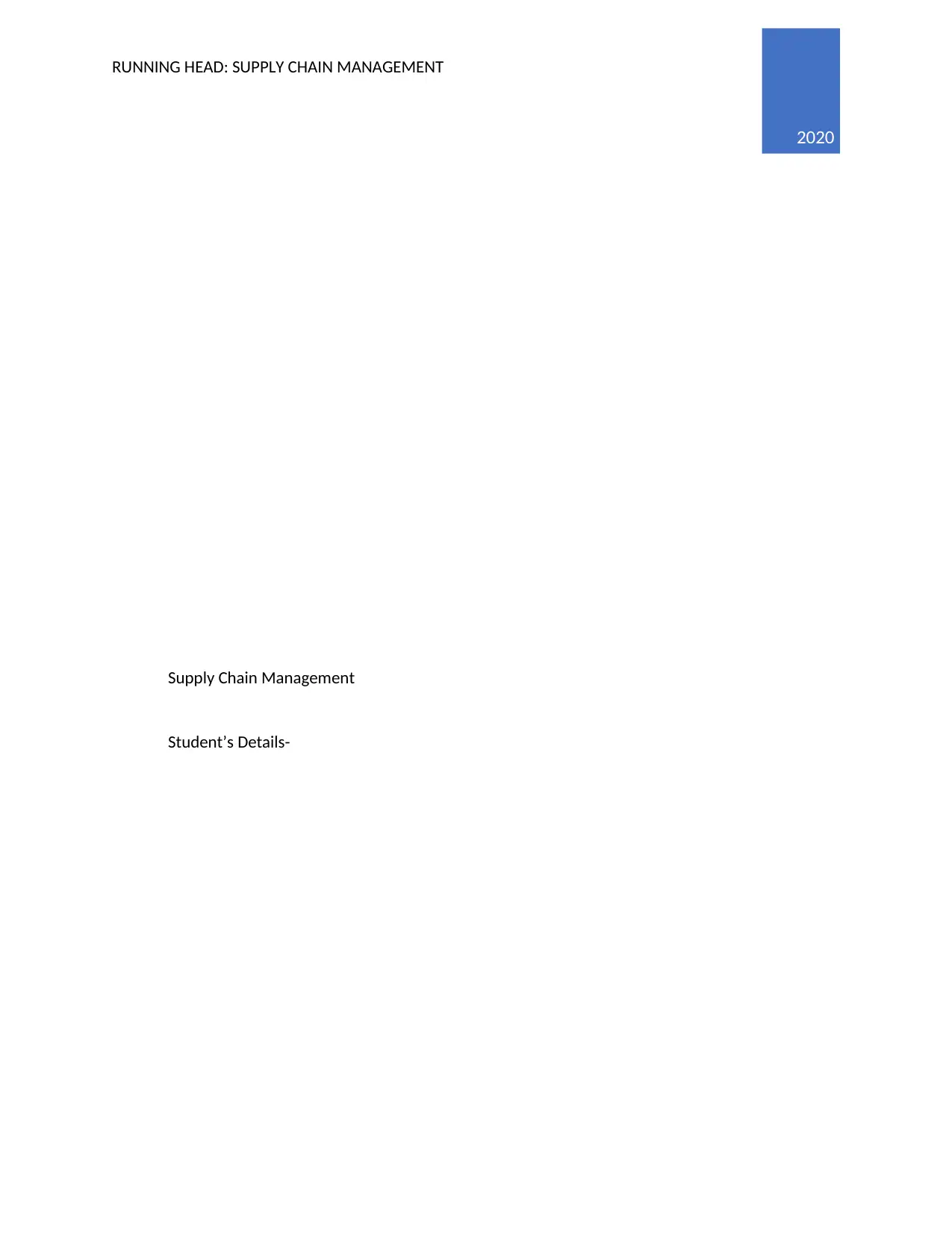
RUNNING HEAD: SUPPLY CHAIN MANAGEMENT 0
2020
Supply Chain Management
Student’s Details-
2020
Supply Chain Management
Student’s Details-
Paraphrase This Document
Need a fresh take? Get an instant paraphrase of this document with our AI Paraphraser
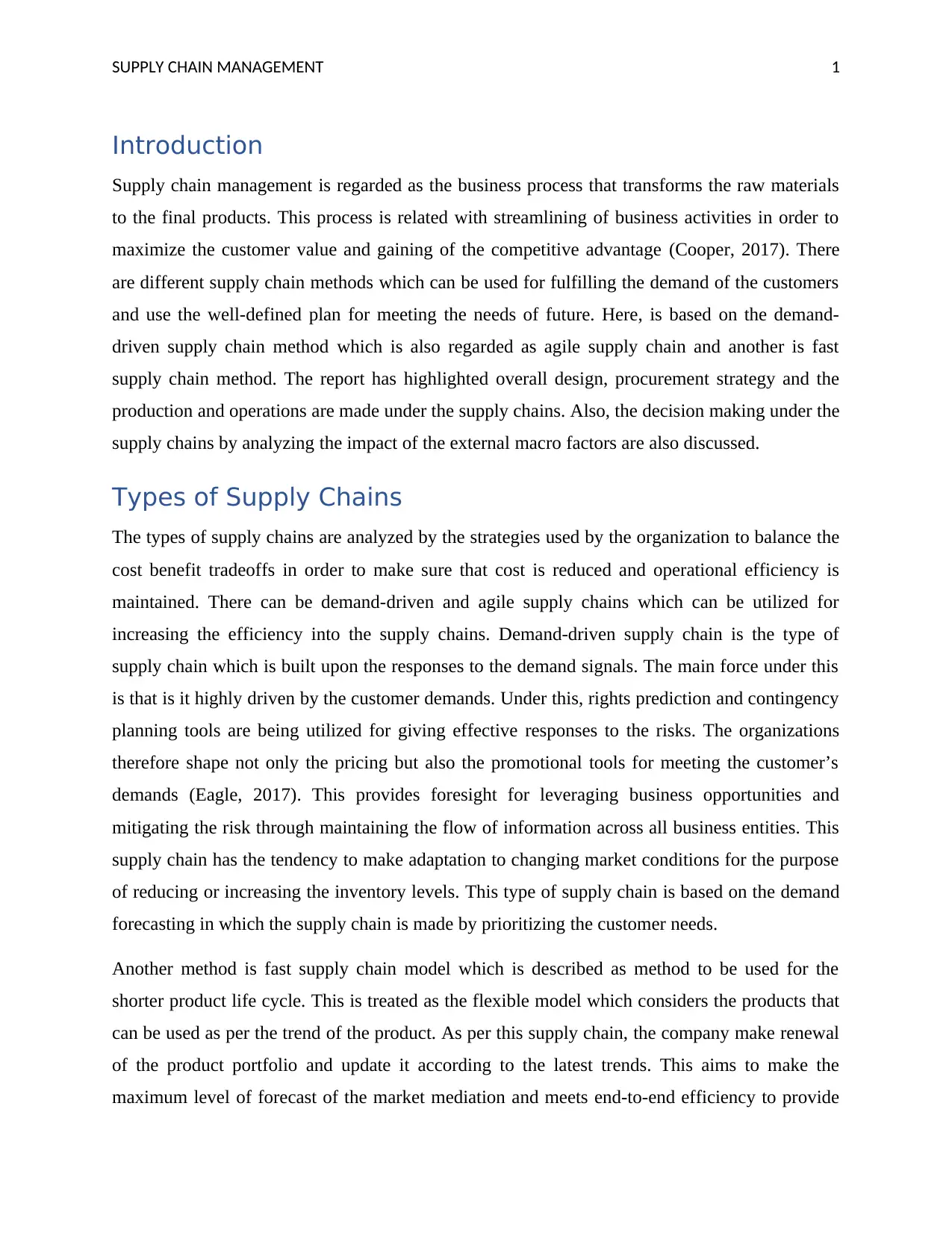
SUPPLY CHAIN MANAGEMENT 1
Introduction
Supply chain management is regarded as the business process that transforms the raw materials
to the final products. This process is related with streamlining of business activities in order to
maximize the customer value and gaining of the competitive advantage (Cooper, 2017). There
are different supply chain methods which can be used for fulfilling the demand of the customers
and use the well-defined plan for meeting the needs of future. Here, is based on the demand-
driven supply chain method which is also regarded as agile supply chain and another is fast
supply chain method. The report has highlighted overall design, procurement strategy and the
production and operations are made under the supply chains. Also, the decision making under the
supply chains by analyzing the impact of the external macro factors are also discussed.
Types of Supply Chains
The types of supply chains are analyzed by the strategies used by the organization to balance the
cost benefit tradeoffs in order to make sure that cost is reduced and operational efficiency is
maintained. There can be demand-driven and agile supply chains which can be utilized for
increasing the efficiency into the supply chains. Demand-driven supply chain is the type of
supply chain which is built upon the responses to the demand signals. The main force under this
is that is it highly driven by the customer demands. Under this, rights prediction and contingency
planning tools are being utilized for giving effective responses to the risks. The organizations
therefore shape not only the pricing but also the promotional tools for meeting the customer’s
demands (Eagle, 2017). This provides foresight for leveraging business opportunities and
mitigating the risk through maintaining the flow of information across all business entities. This
supply chain has the tendency to make adaptation to changing market conditions for the purpose
of reducing or increasing the inventory levels. This type of supply chain is based on the demand
forecasting in which the supply chain is made by prioritizing the customer needs.
Another method is fast supply chain model which is described as method to be used for the
shorter product life cycle. This is treated as the flexible model which considers the products that
can be used as per the trend of the product. As per this supply chain, the company make renewal
of the product portfolio and update it according to the latest trends. This aims to make the
maximum level of forecast of the market mediation and meets end-to-end efficiency to provide
Introduction
Supply chain management is regarded as the business process that transforms the raw materials
to the final products. This process is related with streamlining of business activities in order to
maximize the customer value and gaining of the competitive advantage (Cooper, 2017). There
are different supply chain methods which can be used for fulfilling the demand of the customers
and use the well-defined plan for meeting the needs of future. Here, is based on the demand-
driven supply chain method which is also regarded as agile supply chain and another is fast
supply chain method. The report has highlighted overall design, procurement strategy and the
production and operations are made under the supply chains. Also, the decision making under the
supply chains by analyzing the impact of the external macro factors are also discussed.
Types of Supply Chains
The types of supply chains are analyzed by the strategies used by the organization to balance the
cost benefit tradeoffs in order to make sure that cost is reduced and operational efficiency is
maintained. There can be demand-driven and agile supply chains which can be utilized for
increasing the efficiency into the supply chains. Demand-driven supply chain is the type of
supply chain which is built upon the responses to the demand signals. The main force under this
is that is it highly driven by the customer demands. Under this, rights prediction and contingency
planning tools are being utilized for giving effective responses to the risks. The organizations
therefore shape not only the pricing but also the promotional tools for meeting the customer’s
demands (Eagle, 2017). This provides foresight for leveraging business opportunities and
mitigating the risk through maintaining the flow of information across all business entities. This
supply chain has the tendency to make adaptation to changing market conditions for the purpose
of reducing or increasing the inventory levels. This type of supply chain is based on the demand
forecasting in which the supply chain is made by prioritizing the customer needs.
Another method is fast supply chain model which is described as method to be used for the
shorter product life cycle. This is treated as the flexible model which considers the products that
can be used as per the trend of the product. As per this supply chain, the company make renewal
of the product portfolio and update it according to the latest trends. This aims to make the
maximum level of forecast of the market mediation and meets end-to-end efficiency to provide
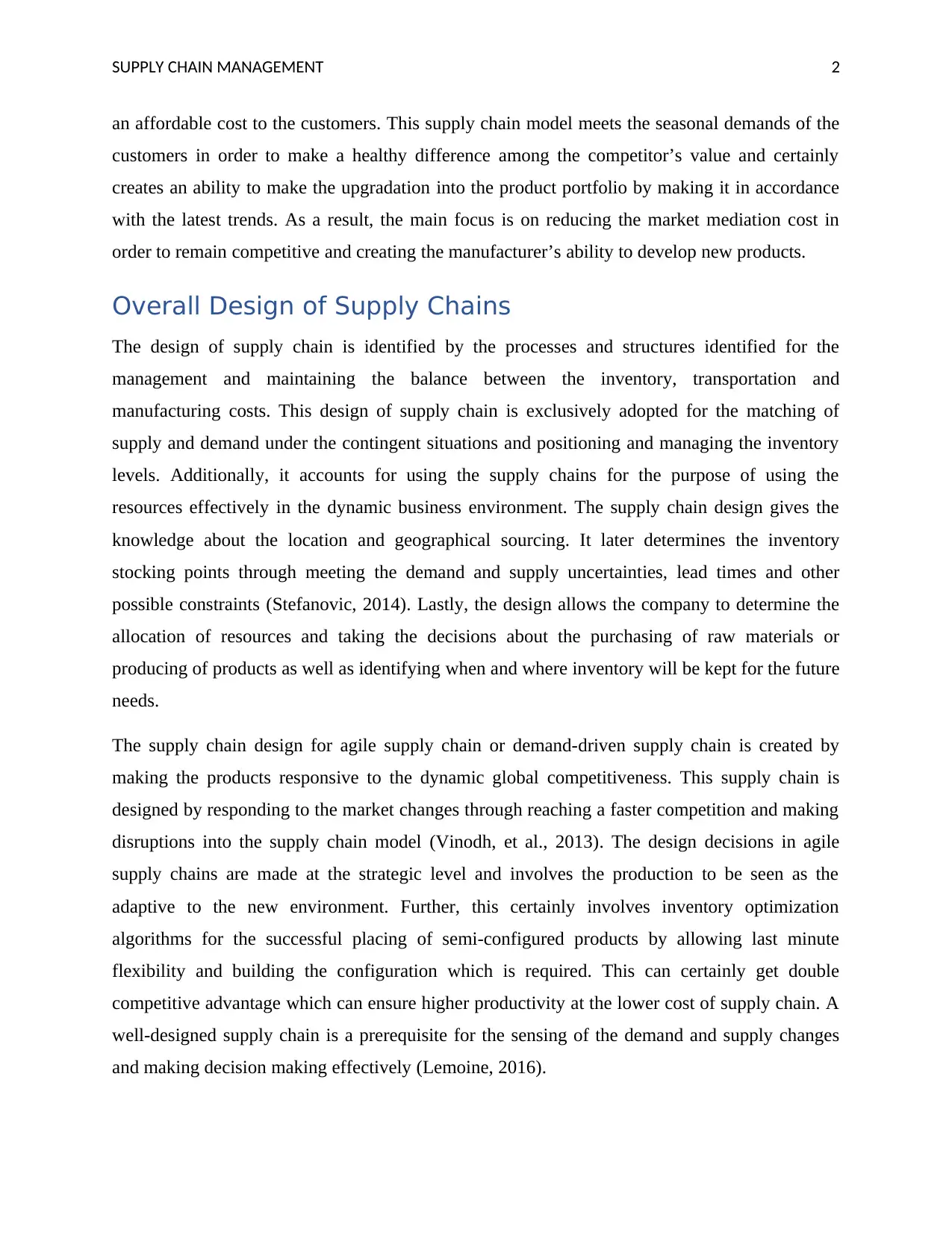
SUPPLY CHAIN MANAGEMENT 2
an affordable cost to the customers. This supply chain model meets the seasonal demands of the
customers in order to make a healthy difference among the competitor’s value and certainly
creates an ability to make the upgradation into the product portfolio by making it in accordance
with the latest trends. As a result, the main focus is on reducing the market mediation cost in
order to remain competitive and creating the manufacturer’s ability to develop new products.
Overall Design of Supply Chains
The design of supply chain is identified by the processes and structures identified for the
management and maintaining the balance between the inventory, transportation and
manufacturing costs. This design of supply chain is exclusively adopted for the matching of
supply and demand under the contingent situations and positioning and managing the inventory
levels. Additionally, it accounts for using the supply chains for the purpose of using the
resources effectively in the dynamic business environment. The supply chain design gives the
knowledge about the location and geographical sourcing. It later determines the inventory
stocking points through meeting the demand and supply uncertainties, lead times and other
possible constraints (Stefanovic, 2014). Lastly, the design allows the company to determine the
allocation of resources and taking the decisions about the purchasing of raw materials or
producing of products as well as identifying when and where inventory will be kept for the future
needs.
The supply chain design for agile supply chain or demand-driven supply chain is created by
making the products responsive to the dynamic global competitiveness. This supply chain is
designed by responding to the market changes through reaching a faster competition and making
disruptions into the supply chain model (Vinodh, et al., 2013). The design decisions in agile
supply chains are made at the strategic level and involves the production to be seen as the
adaptive to the new environment. Further, this certainly involves inventory optimization
algorithms for the successful placing of semi-configured products by allowing last minute
flexibility and building the configuration which is required. This can certainly get double
competitive advantage which can ensure higher productivity at the lower cost of supply chain. A
well-designed supply chain is a prerequisite for the sensing of the demand and supply changes
and making decision making effectively (Lemoine, 2016).
an affordable cost to the customers. This supply chain model meets the seasonal demands of the
customers in order to make a healthy difference among the competitor’s value and certainly
creates an ability to make the upgradation into the product portfolio by making it in accordance
with the latest trends. As a result, the main focus is on reducing the market mediation cost in
order to remain competitive and creating the manufacturer’s ability to develop new products.
Overall Design of Supply Chains
The design of supply chain is identified by the processes and structures identified for the
management and maintaining the balance between the inventory, transportation and
manufacturing costs. This design of supply chain is exclusively adopted for the matching of
supply and demand under the contingent situations and positioning and managing the inventory
levels. Additionally, it accounts for using the supply chains for the purpose of using the
resources effectively in the dynamic business environment. The supply chain design gives the
knowledge about the location and geographical sourcing. It later determines the inventory
stocking points through meeting the demand and supply uncertainties, lead times and other
possible constraints (Stefanovic, 2014). Lastly, the design allows the company to determine the
allocation of resources and taking the decisions about the purchasing of raw materials or
producing of products as well as identifying when and where inventory will be kept for the future
needs.
The supply chain design for agile supply chain or demand-driven supply chain is created by
making the products responsive to the dynamic global competitiveness. This supply chain is
designed by responding to the market changes through reaching a faster competition and making
disruptions into the supply chain model (Vinodh, et al., 2013). The design decisions in agile
supply chains are made at the strategic level and involves the production to be seen as the
adaptive to the new environment. Further, this certainly involves inventory optimization
algorithms for the successful placing of semi-configured products by allowing last minute
flexibility and building the configuration which is required. This can certainly get double
competitive advantage which can ensure higher productivity at the lower cost of supply chain. A
well-designed supply chain is a prerequisite for the sensing of the demand and supply changes
and making decision making effectively (Lemoine, 2016).
⊘ This is a preview!⊘
Do you want full access?
Subscribe today to unlock all pages.

Trusted by 1+ million students worldwide
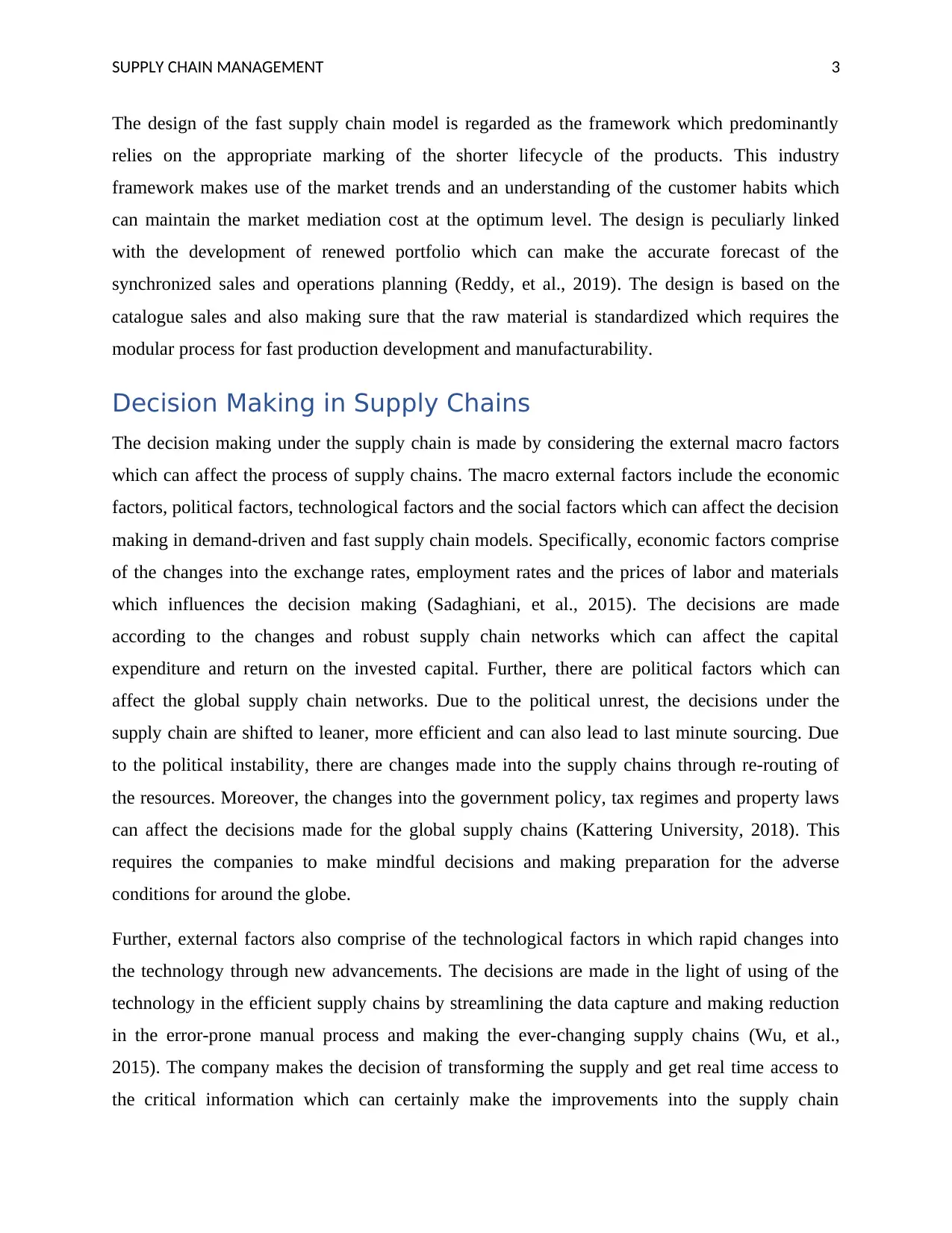
SUPPLY CHAIN MANAGEMENT 3
The design of the fast supply chain model is regarded as the framework which predominantly
relies on the appropriate marking of the shorter lifecycle of the products. This industry
framework makes use of the market trends and an understanding of the customer habits which
can maintain the market mediation cost at the optimum level. The design is peculiarly linked
with the development of renewed portfolio which can make the accurate forecast of the
synchronized sales and operations planning (Reddy, et al., 2019). The design is based on the
catalogue sales and also making sure that the raw material is standardized which requires the
modular process for fast production development and manufacturability.
Decision Making in Supply Chains
The decision making under the supply chain is made by considering the external macro factors
which can affect the process of supply chains. The macro external factors include the economic
factors, political factors, technological factors and the social factors which can affect the decision
making in demand-driven and fast supply chain models. Specifically, economic factors comprise
of the changes into the exchange rates, employment rates and the prices of labor and materials
which influences the decision making (Sadaghiani, et al., 2015). The decisions are made
according to the changes and robust supply chain networks which can affect the capital
expenditure and return on the invested capital. Further, there are political factors which can
affect the global supply chain networks. Due to the political unrest, the decisions under the
supply chain are shifted to leaner, more efficient and can also lead to last minute sourcing. Due
to the political instability, there are changes made into the supply chains through re-routing of
the resources. Moreover, the changes into the government policy, tax regimes and property laws
can affect the decisions made for the global supply chains (Kattering University, 2018). This
requires the companies to make mindful decisions and making preparation for the adverse
conditions for around the globe.
Further, external factors also comprise of the technological factors in which rapid changes into
the technology through new advancements. The decisions are made in the light of using of the
technology in the efficient supply chains by streamlining the data capture and making reduction
in the error-prone manual process and making the ever-changing supply chains (Wu, et al.,
2015). The company makes the decision of transforming the supply and get real time access to
the critical information which can certainly make the improvements into the supply chain
The design of the fast supply chain model is regarded as the framework which predominantly
relies on the appropriate marking of the shorter lifecycle of the products. This industry
framework makes use of the market trends and an understanding of the customer habits which
can maintain the market mediation cost at the optimum level. The design is peculiarly linked
with the development of renewed portfolio which can make the accurate forecast of the
synchronized sales and operations planning (Reddy, et al., 2019). The design is based on the
catalogue sales and also making sure that the raw material is standardized which requires the
modular process for fast production development and manufacturability.
Decision Making in Supply Chains
The decision making under the supply chain is made by considering the external macro factors
which can affect the process of supply chains. The macro external factors include the economic
factors, political factors, technological factors and the social factors which can affect the decision
making in demand-driven and fast supply chain models. Specifically, economic factors comprise
of the changes into the exchange rates, employment rates and the prices of labor and materials
which influences the decision making (Sadaghiani, et al., 2015). The decisions are made
according to the changes and robust supply chain networks which can affect the capital
expenditure and return on the invested capital. Further, there are political factors which can
affect the global supply chain networks. Due to the political unrest, the decisions under the
supply chain are shifted to leaner, more efficient and can also lead to last minute sourcing. Due
to the political instability, there are changes made into the supply chains through re-routing of
the resources. Moreover, the changes into the government policy, tax regimes and property laws
can affect the decisions made for the global supply chains (Kattering University, 2018). This
requires the companies to make mindful decisions and making preparation for the adverse
conditions for around the globe.
Further, external factors also comprise of the technological factors in which rapid changes into
the technology through new advancements. The decisions are made in the light of using of the
technology in the efficient supply chains by streamlining the data capture and making reduction
in the error-prone manual process and making the ever-changing supply chains (Wu, et al.,
2015). The company makes the decision of transforming the supply and get real time access to
the critical information which can certainly make the improvements into the supply chain
Paraphrase This Document
Need a fresh take? Get an instant paraphrase of this document with our AI Paraphraser
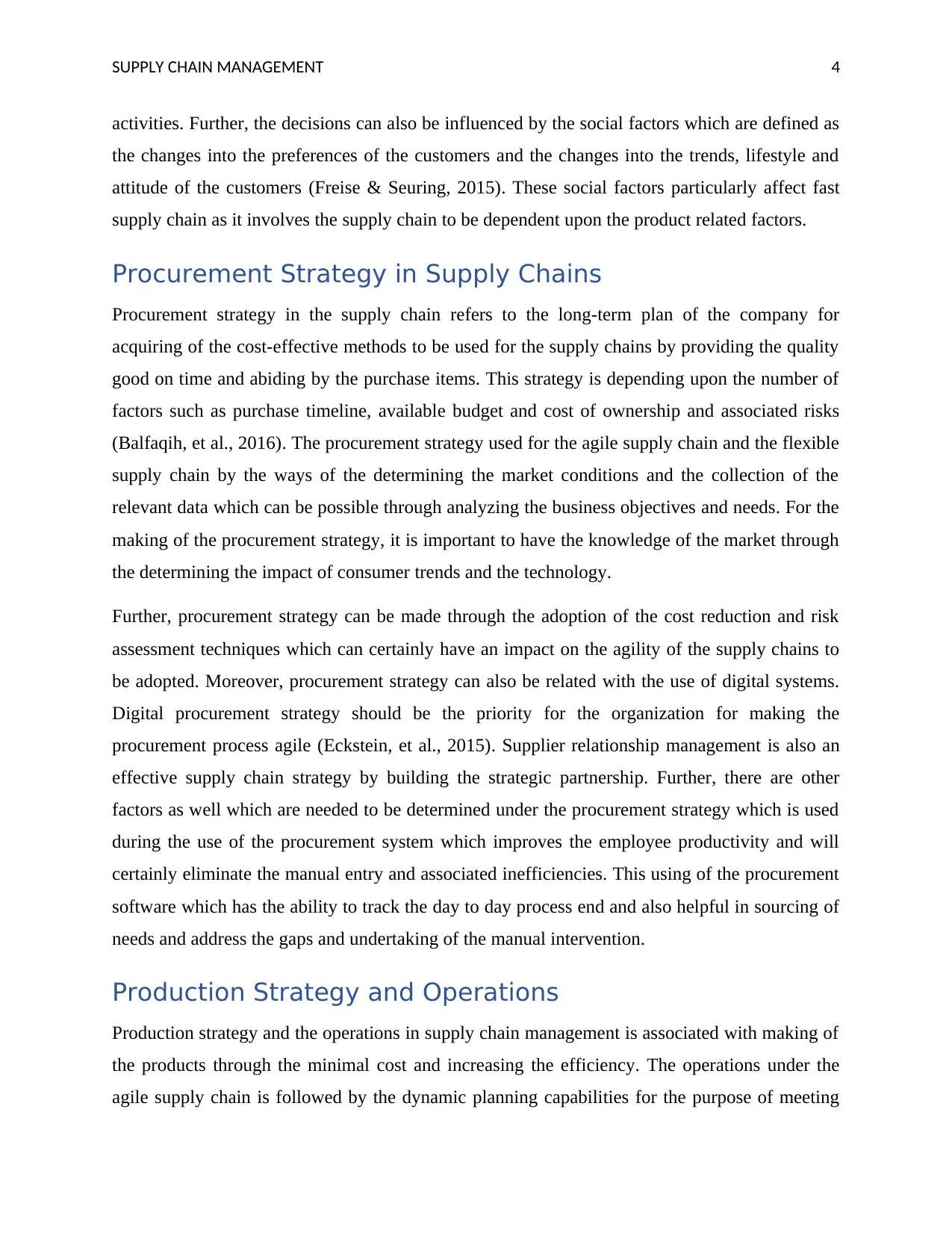
SUPPLY CHAIN MANAGEMENT 4
activities. Further, the decisions can also be influenced by the social factors which are defined as
the changes into the preferences of the customers and the changes into the trends, lifestyle and
attitude of the customers (Freise & Seuring, 2015). These social factors particularly affect fast
supply chain as it involves the supply chain to be dependent upon the product related factors.
Procurement Strategy in Supply Chains
Procurement strategy in the supply chain refers to the long-term plan of the company for
acquiring of the cost-effective methods to be used for the supply chains by providing the quality
good on time and abiding by the purchase items. This strategy is depending upon the number of
factors such as purchase timeline, available budget and cost of ownership and associated risks
(Balfaqih, et al., 2016). The procurement strategy used for the agile supply chain and the flexible
supply chain by the ways of the determining the market conditions and the collection of the
relevant data which can be possible through analyzing the business objectives and needs. For the
making of the procurement strategy, it is important to have the knowledge of the market through
the determining the impact of consumer trends and the technology.
Further, procurement strategy can be made through the adoption of the cost reduction and risk
assessment techniques which can certainly have an impact on the agility of the supply chains to
be adopted. Moreover, procurement strategy can also be related with the use of digital systems.
Digital procurement strategy should be the priority for the organization for making the
procurement process agile (Eckstein, et al., 2015). Supplier relationship management is also an
effective supply chain strategy by building the strategic partnership. Further, there are other
factors as well which are needed to be determined under the procurement strategy which is used
during the use of the procurement system which improves the employee productivity and will
certainly eliminate the manual entry and associated inefficiencies. This using of the procurement
software which has the ability to track the day to day process end and also helpful in sourcing of
needs and address the gaps and undertaking of the manual intervention.
Production Strategy and Operations
Production strategy and the operations in supply chain management is associated with making of
the products through the minimal cost and increasing the efficiency. The operations under the
agile supply chain is followed by the dynamic planning capabilities for the purpose of meeting
activities. Further, the decisions can also be influenced by the social factors which are defined as
the changes into the preferences of the customers and the changes into the trends, lifestyle and
attitude of the customers (Freise & Seuring, 2015). These social factors particularly affect fast
supply chain as it involves the supply chain to be dependent upon the product related factors.
Procurement Strategy in Supply Chains
Procurement strategy in the supply chain refers to the long-term plan of the company for
acquiring of the cost-effective methods to be used for the supply chains by providing the quality
good on time and abiding by the purchase items. This strategy is depending upon the number of
factors such as purchase timeline, available budget and cost of ownership and associated risks
(Balfaqih, et al., 2016). The procurement strategy used for the agile supply chain and the flexible
supply chain by the ways of the determining the market conditions and the collection of the
relevant data which can be possible through analyzing the business objectives and needs. For the
making of the procurement strategy, it is important to have the knowledge of the market through
the determining the impact of consumer trends and the technology.
Further, procurement strategy can be made through the adoption of the cost reduction and risk
assessment techniques which can certainly have an impact on the agility of the supply chains to
be adopted. Moreover, procurement strategy can also be related with the use of digital systems.
Digital procurement strategy should be the priority for the organization for making the
procurement process agile (Eckstein, et al., 2015). Supplier relationship management is also an
effective supply chain strategy by building the strategic partnership. Further, there are other
factors as well which are needed to be determined under the procurement strategy which is used
during the use of the procurement system which improves the employee productivity and will
certainly eliminate the manual entry and associated inefficiencies. This using of the procurement
software which has the ability to track the day to day process end and also helpful in sourcing of
needs and address the gaps and undertaking of the manual intervention.
Production Strategy and Operations
Production strategy and the operations in supply chain management is associated with making of
the products through the minimal cost and increasing the efficiency. The operations under the
agile supply chain is followed by the dynamic planning capabilities for the purpose of meeting
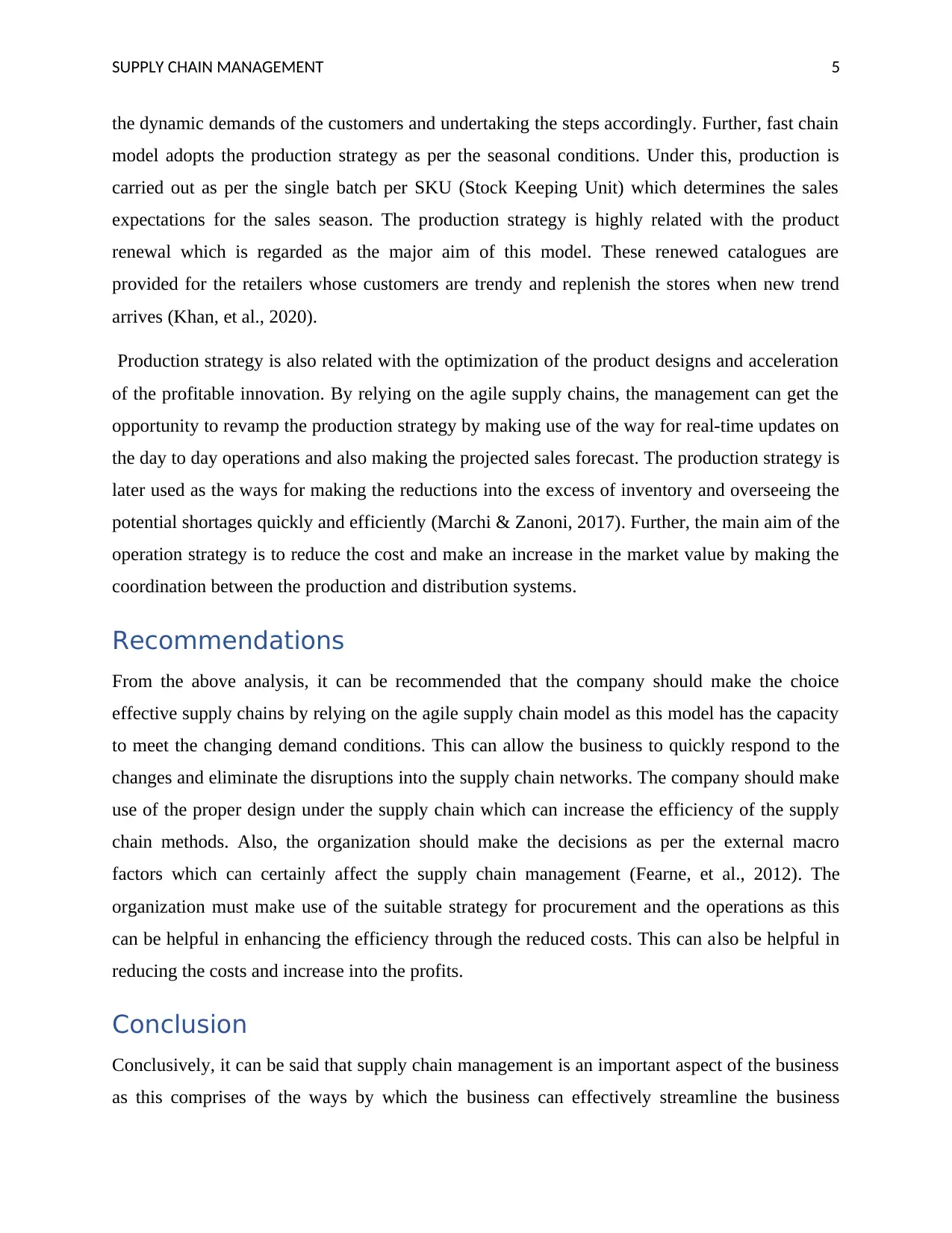
SUPPLY CHAIN MANAGEMENT 5
the dynamic demands of the customers and undertaking the steps accordingly. Further, fast chain
model adopts the production strategy as per the seasonal conditions. Under this, production is
carried out as per the single batch per SKU (Stock Keeping Unit) which determines the sales
expectations for the sales season. The production strategy is highly related with the product
renewal which is regarded as the major aim of this model. These renewed catalogues are
provided for the retailers whose customers are trendy and replenish the stores when new trend
arrives (Khan, et al., 2020).
Production strategy is also related with the optimization of the product designs and acceleration
of the profitable innovation. By relying on the agile supply chains, the management can get the
opportunity to revamp the production strategy by making use of the way for real-time updates on
the day to day operations and also making the projected sales forecast. The production strategy is
later used as the ways for making the reductions into the excess of inventory and overseeing the
potential shortages quickly and efficiently (Marchi & Zanoni, 2017). Further, the main aim of the
operation strategy is to reduce the cost and make an increase in the market value by making the
coordination between the production and distribution systems.
Recommendations
From the above analysis, it can be recommended that the company should make the choice
effective supply chains by relying on the agile supply chain model as this model has the capacity
to meet the changing demand conditions. This can allow the business to quickly respond to the
changes and eliminate the disruptions into the supply chain networks. The company should make
use of the proper design under the supply chain which can increase the efficiency of the supply
chain methods. Also, the organization should make the decisions as per the external macro
factors which can certainly affect the supply chain management (Fearne, et al., 2012). The
organization must make use of the suitable strategy for procurement and the operations as this
can be helpful in enhancing the efficiency through the reduced costs. This can also be helpful in
reducing the costs and increase into the profits.
Conclusion
Conclusively, it can be said that supply chain management is an important aspect of the business
as this comprises of the ways by which the business can effectively streamline the business
the dynamic demands of the customers and undertaking the steps accordingly. Further, fast chain
model adopts the production strategy as per the seasonal conditions. Under this, production is
carried out as per the single batch per SKU (Stock Keeping Unit) which determines the sales
expectations for the sales season. The production strategy is highly related with the product
renewal which is regarded as the major aim of this model. These renewed catalogues are
provided for the retailers whose customers are trendy and replenish the stores when new trend
arrives (Khan, et al., 2020).
Production strategy is also related with the optimization of the product designs and acceleration
of the profitable innovation. By relying on the agile supply chains, the management can get the
opportunity to revamp the production strategy by making use of the way for real-time updates on
the day to day operations and also making the projected sales forecast. The production strategy is
later used as the ways for making the reductions into the excess of inventory and overseeing the
potential shortages quickly and efficiently (Marchi & Zanoni, 2017). Further, the main aim of the
operation strategy is to reduce the cost and make an increase in the market value by making the
coordination between the production and distribution systems.
Recommendations
From the above analysis, it can be recommended that the company should make the choice
effective supply chains by relying on the agile supply chain model as this model has the capacity
to meet the changing demand conditions. This can allow the business to quickly respond to the
changes and eliminate the disruptions into the supply chain networks. The company should make
use of the proper design under the supply chain which can increase the efficiency of the supply
chain methods. Also, the organization should make the decisions as per the external macro
factors which can certainly affect the supply chain management (Fearne, et al., 2012). The
organization must make use of the suitable strategy for procurement and the operations as this
can be helpful in enhancing the efficiency through the reduced costs. This can also be helpful in
reducing the costs and increase into the profits.
Conclusion
Conclusively, it can be said that supply chain management is an important aspect of the business
as this comprises of the ways by which the business can effectively streamline the business
⊘ This is a preview!⊘
Do you want full access?
Subscribe today to unlock all pages.

Trusted by 1+ million students worldwide
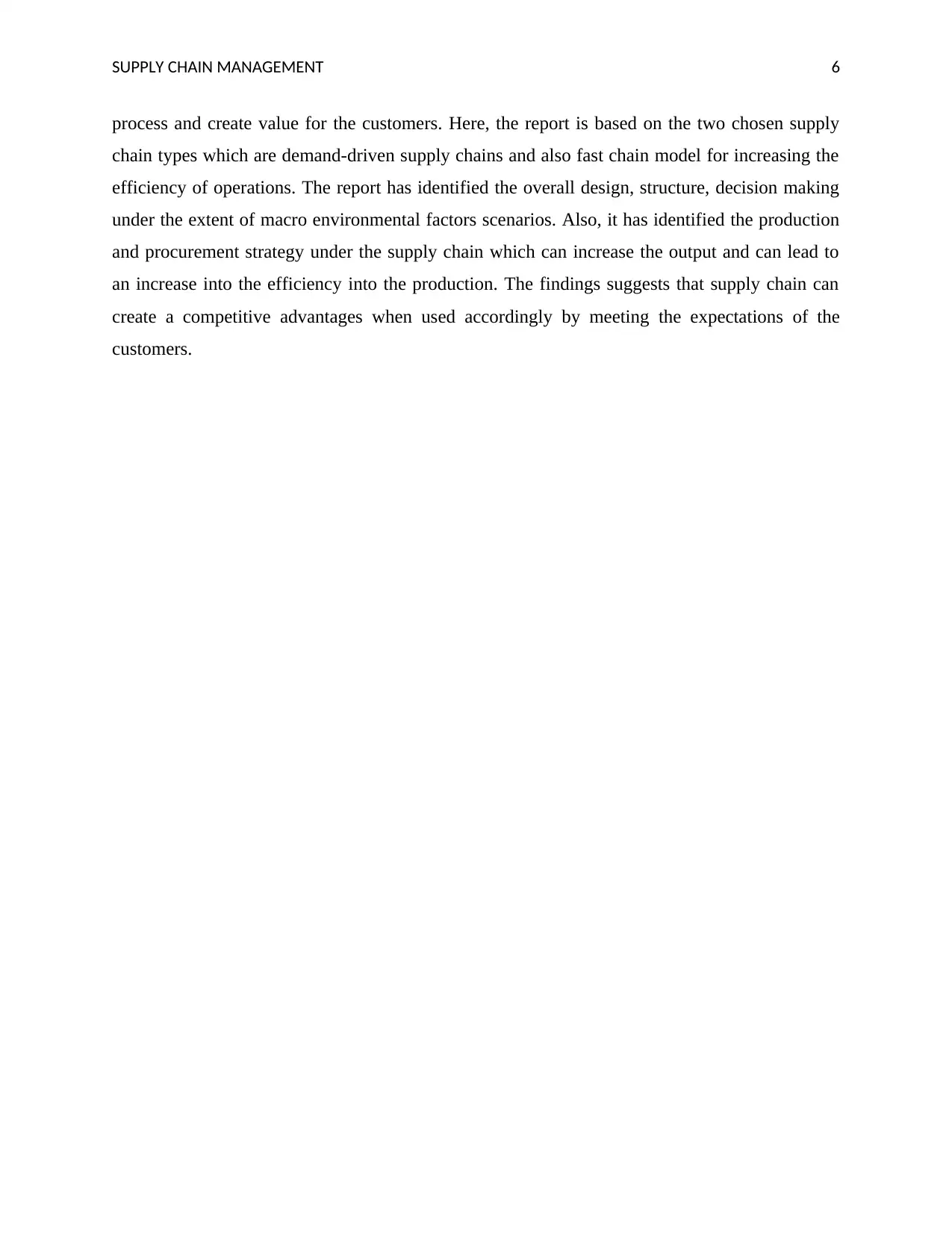
SUPPLY CHAIN MANAGEMENT 6
process and create value for the customers. Here, the report is based on the two chosen supply
chain types which are demand-driven supply chains and also fast chain model for increasing the
efficiency of operations. The report has identified the overall design, structure, decision making
under the extent of macro environmental factors scenarios. Also, it has identified the production
and procurement strategy under the supply chain which can increase the output and can lead to
an increase into the efficiency into the production. The findings suggests that supply chain can
create a competitive advantages when used accordingly by meeting the expectations of the
customers.
process and create value for the customers. Here, the report is based on the two chosen supply
chain types which are demand-driven supply chains and also fast chain model for increasing the
efficiency of operations. The report has identified the overall design, structure, decision making
under the extent of macro environmental factors scenarios. Also, it has identified the production
and procurement strategy under the supply chain which can increase the output and can lead to
an increase into the efficiency into the production. The findings suggests that supply chain can
create a competitive advantages when used accordingly by meeting the expectations of the
customers.
Paraphrase This Document
Need a fresh take? Get an instant paraphrase of this document with our AI Paraphraser
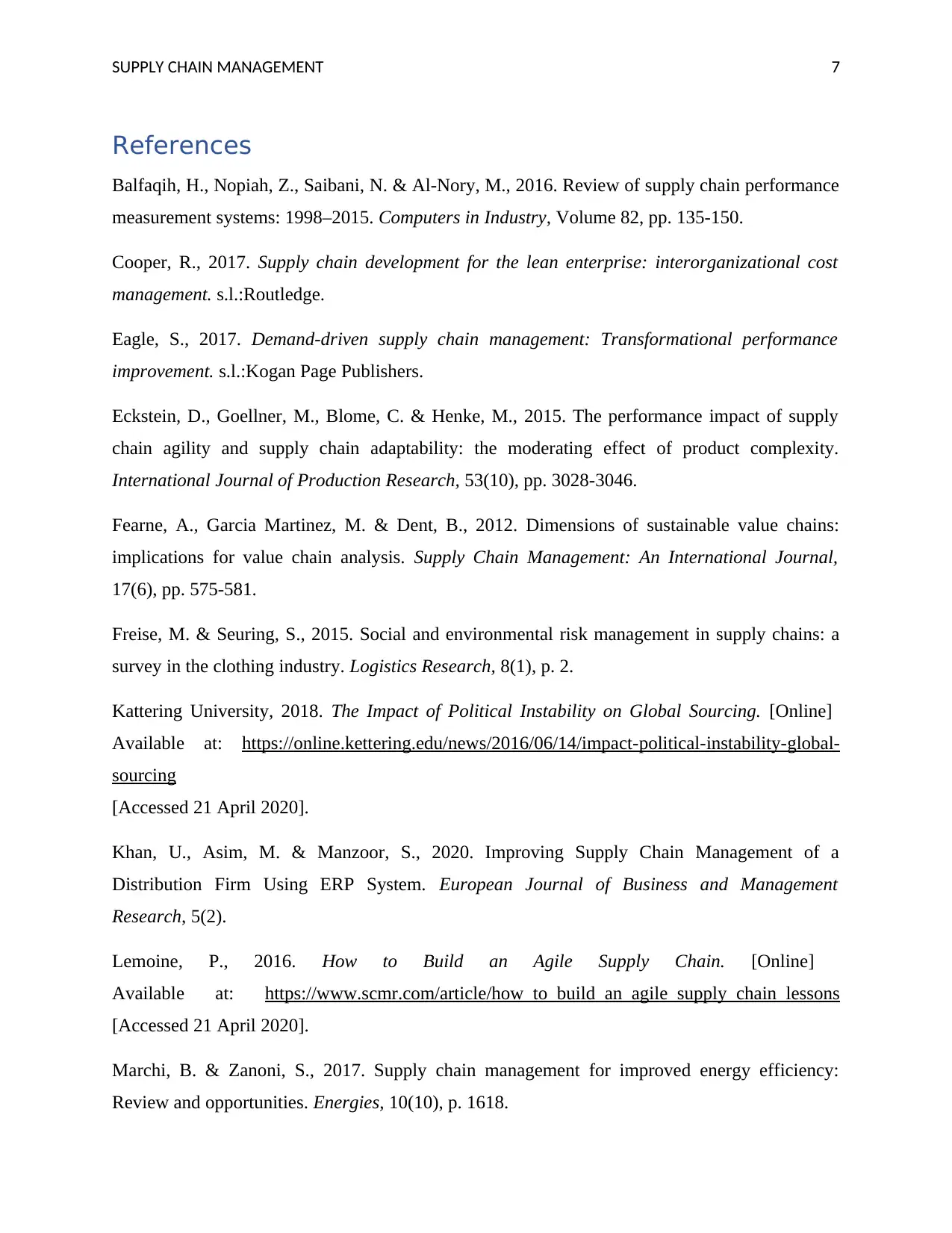
SUPPLY CHAIN MANAGEMENT 7
References
Balfaqih, H., Nopiah, Z., Saibani, N. & Al-Nory, M., 2016. Review of supply chain performance
measurement systems: 1998–2015. Computers in Industry, Volume 82, pp. 135-150.
Cooper, R., 2017. Supply chain development for the lean enterprise: interorganizational cost
management. s.l.:Routledge.
Eagle, S., 2017. Demand-driven supply chain management: Transformational performance
improvement. s.l.:Kogan Page Publishers.
Eckstein, D., Goellner, M., Blome, C. & Henke, M., 2015. The performance impact of supply
chain agility and supply chain adaptability: the moderating effect of product complexity.
International Journal of Production Research, 53(10), pp. 3028-3046.
Fearne, A., Garcia Martinez, M. & Dent, B., 2012. Dimensions of sustainable value chains:
implications for value chain analysis. Supply Chain Management: An International Journal,
17(6), pp. 575-581.
Freise, M. & Seuring, S., 2015. Social and environmental risk management in supply chains: a
survey in the clothing industry. Logistics Research, 8(1), p. 2.
Kattering University, 2018. The Impact of Political Instability on Global Sourcing. [Online]
Available at: https://online.kettering.edu/news/2016/06/14/impact-political-instability-global-
sourcing
[Accessed 21 April 2020].
Khan, U., Asim, M. & Manzoor, S., 2020. Improving Supply Chain Management of a
Distribution Firm Using ERP System. European Journal of Business and Management
Research, 5(2).
Lemoine, P., 2016. How to Build an Agile Supply Chain. [Online]
Available at: https://www.scmr.com/article/how_to_build_an_agile_supply_chain_lessons
[Accessed 21 April 2020].
Marchi, B. & Zanoni, S., 2017. Supply chain management for improved energy efficiency:
Review and opportunities. Energies, 10(10), p. 1618.
References
Balfaqih, H., Nopiah, Z., Saibani, N. & Al-Nory, M., 2016. Review of supply chain performance
measurement systems: 1998–2015. Computers in Industry, Volume 82, pp. 135-150.
Cooper, R., 2017. Supply chain development for the lean enterprise: interorganizational cost
management. s.l.:Routledge.
Eagle, S., 2017. Demand-driven supply chain management: Transformational performance
improvement. s.l.:Kogan Page Publishers.
Eckstein, D., Goellner, M., Blome, C. & Henke, M., 2015. The performance impact of supply
chain agility and supply chain adaptability: the moderating effect of product complexity.
International Journal of Production Research, 53(10), pp. 3028-3046.
Fearne, A., Garcia Martinez, M. & Dent, B., 2012. Dimensions of sustainable value chains:
implications for value chain analysis. Supply Chain Management: An International Journal,
17(6), pp. 575-581.
Freise, M. & Seuring, S., 2015. Social and environmental risk management in supply chains: a
survey in the clothing industry. Logistics Research, 8(1), p. 2.
Kattering University, 2018. The Impact of Political Instability on Global Sourcing. [Online]
Available at: https://online.kettering.edu/news/2016/06/14/impact-political-instability-global-
sourcing
[Accessed 21 April 2020].
Khan, U., Asim, M. & Manzoor, S., 2020. Improving Supply Chain Management of a
Distribution Firm Using ERP System. European Journal of Business and Management
Research, 5(2).
Lemoine, P., 2016. How to Build an Agile Supply Chain. [Online]
Available at: https://www.scmr.com/article/how_to_build_an_agile_supply_chain_lessons
[Accessed 21 April 2020].
Marchi, B. & Zanoni, S., 2017. Supply chain management for improved energy efficiency:
Review and opportunities. Energies, 10(10), p. 1618.
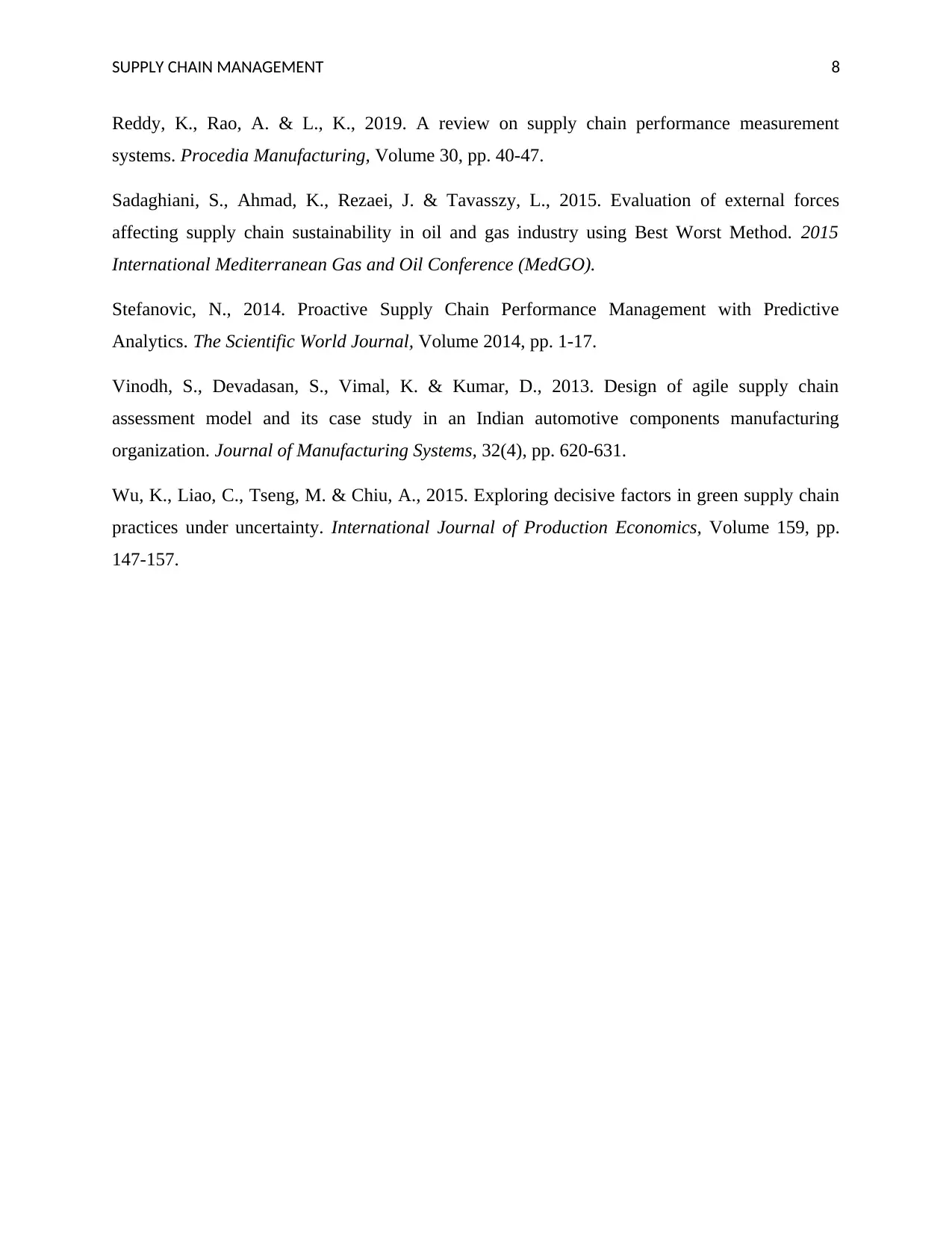
SUPPLY CHAIN MANAGEMENT 8
Reddy, K., Rao, A. & L., K., 2019. A review on supply chain performance measurement
systems. Procedia Manufacturing, Volume 30, pp. 40-47.
Sadaghiani, S., Ahmad, K., Rezaei, J. & Tavasszy, L., 2015. Evaluation of external forces
affecting supply chain sustainability in oil and gas industry using Best Worst Method. 2015
International Mediterranean Gas and Oil Conference (MedGO).
Stefanovic, N., 2014. Proactive Supply Chain Performance Management with Predictive
Analytics. The Scientific World Journal, Volume 2014, pp. 1-17.
Vinodh, S., Devadasan, S., Vimal, K. & Kumar, D., 2013. Design of agile supply chain
assessment model and its case study in an Indian automotive components manufacturing
organization. Journal of Manufacturing Systems, 32(4), pp. 620-631.
Wu, K., Liao, C., Tseng, M. & Chiu, A., 2015. Exploring decisive factors in green supply chain
practices under uncertainty. International Journal of Production Economics, Volume 159, pp.
147-157.
Reddy, K., Rao, A. & L., K., 2019. A review on supply chain performance measurement
systems. Procedia Manufacturing, Volume 30, pp. 40-47.
Sadaghiani, S., Ahmad, K., Rezaei, J. & Tavasszy, L., 2015. Evaluation of external forces
affecting supply chain sustainability in oil and gas industry using Best Worst Method. 2015
International Mediterranean Gas and Oil Conference (MedGO).
Stefanovic, N., 2014. Proactive Supply Chain Performance Management with Predictive
Analytics. The Scientific World Journal, Volume 2014, pp. 1-17.
Vinodh, S., Devadasan, S., Vimal, K. & Kumar, D., 2013. Design of agile supply chain
assessment model and its case study in an Indian automotive components manufacturing
organization. Journal of Manufacturing Systems, 32(4), pp. 620-631.
Wu, K., Liao, C., Tseng, M. & Chiu, A., 2015. Exploring decisive factors in green supply chain
practices under uncertainty. International Journal of Production Economics, Volume 159, pp.
147-157.
⊘ This is a preview!⊘
Do you want full access?
Subscribe today to unlock all pages.

Trusted by 1+ million students worldwide
1 out of 9
Related Documents
Your All-in-One AI-Powered Toolkit for Academic Success.
+13062052269
info@desklib.com
Available 24*7 on WhatsApp / Email
![[object Object]](/_next/static/media/star-bottom.7253800d.svg)
Unlock your academic potential
Copyright © 2020–2025 A2Z Services. All Rights Reserved. Developed and managed by ZUCOL.





